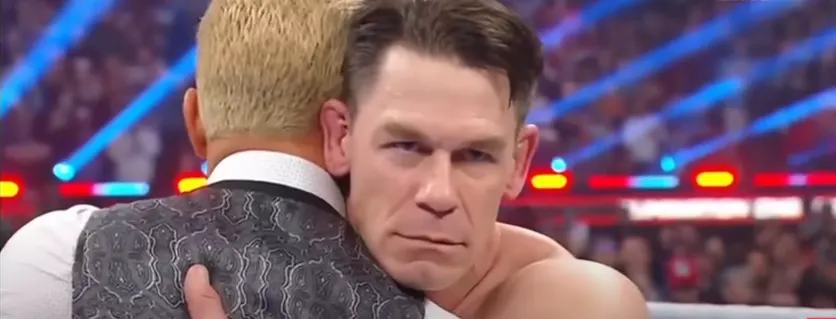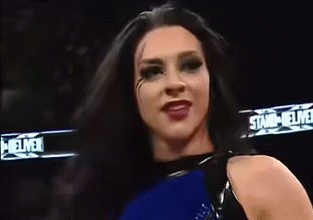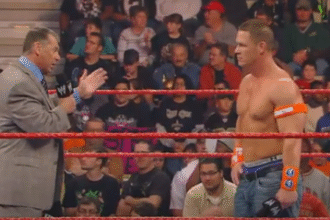John Cena is not afraid to tell it like it is, and once more, the WWE legend provided viewers with an unedited presentation of his life. It was regarding one of the most controversially discussed what-ifs in professional wrestling history, this time, his possible heel turn.
Cena himself acknowledged this in his recent interview when asked whether the WWE ever considered letting him put his clean-cut, Hustle, Loyalty, Respect image aside to have a more darker, villainous reign, where he remarked that the idea never really stuck. His verdict? The venture flopped.
As fans continue to debate whether or not John Cena should have gone heel at the height of his performance, the man himself does not hesitate to state that the creative flame never caught on fire as it should have.
Why Heel Turn Never Took
Face and heel relationships are the blood of the wrestling storytelling. Since Hulk Hogan pulled the shocker of turning heel at the 1996 nWo, right through to Roman Reigns transforming into the Tribal Chief, history bears witness to the success of a heel turn being able to restart the career in a meaningful way.
However, Cena was not another superstar. By the mid-2000s, he was literally and figuratively the face of the WWE. He was the highest seller of merchandise and fulfilled the greatest number of Make-A-Wish requests in the history of the brand, and he carried the family-friendly brand.
Cena explained that WWE did experiment with a heel persona behind the scenes, but it didn’t translate. “We tried. I gave it a shot. It bombed. It just didn’t work,”* Cena revealed during a candid discussion.
The biggest reason? The audience simply wasn’t willing to accept him in that role. For every arena that booed him out of the building, there were thousands of kids wearing his neon t-shirts, chanting his catchphrases, and living by his mantra.
Fan Reactions: Mixed, Loud, but Profitable
Anyone who watched WWE between 2005 and 2016 remembers the infamous “Let’s Go Cena / Cena Sucks” chants that became a staple of every arena. Cena was the rare babyface who generated nuclear reactions, both positive and negative, but always loud.
Some fans argued that WWE was stubborn, refusing to pull the trigger on a true heel run when crowds were already booing him. Others believed Cena’s polarizing character was perfect as-is because it gave WWE exactly what it wanted: engagement.
John Cena was the only guy who could get 50% of the crowd to love him and 50% to hate him, and WWE still made money off both. That’s a once-in-a-lifetime star.
Historical Context: The Ones Who Did It
To understand Cena’s position, you have to compare it to history. When Hulk Hogan turned heel in WCW, it was a career-defining shocker. Hogan went from stale and booed to leading the hottest angle in wrestling history. The Rock also made his career pivot by embracing his arrogant heel side before eventually being loved as a babyface.
But Cena was already locked into a corporate role that WWE relied on heavily. Unlike Hogan, who WCW could afford to risk because of an ensemble roster, WWE couldn’t gamble with their number one draw, alienating half the fanbase in the PG Era.
This is why many fans look at Roman Reigns’ heel turn in 2020 as the “what if Cena had done it” scenario. Reigns thrived once he embraced his darker side, something Cena never got the chance to fully pursue.
Cena’s Legacy Regardless
Whether heel or face, Cena’s place in WWE history is undeniable. A 16-time world champion, Hollywood star, and arguably the last true crossover megastar produced by WWE, his ability to divide crowds while still being the company’s anchor is a testament to his unique position.
In hindsight, Cena himself admits the heel experiment wasn’t necessary. “I think I already was the bad guy to a lot of people,” he said in another interview with *“And to the kids, I was the superhero. That balance worked.”
And he’s right, Cena essentially lived in a gray area, something wrestling rarely pulls off. He didn’t need to officially “turn heel” because he was already treated as one by a huge portion of the fanbase.
My Take: Did WWE Miss Out?
Here’s my honest opinion: yes and no.
On one hand, Cena turning heel could have created a legendary run similar to Hogan’s nWo rebirth. Imagine Cena as a manipulative, arrogant champion, weaponizing his corporate backing and mocking fans who once cheered him. That story writes itself.
On the other hand, WWE was a business first. Cena’s mainstream appeal and merchandise power kept the company thriving during a transitional era when stars like The Rock, Stone Cold, and Undertaker were no longer full-time. WWE didn’t need a Cena heel turn because the “split reaction” was already printing money.
In the end, Cena’s own assessment that it “bombed” feels less like regret and more like closure. He knows his lane, he owns it, and wrestling history is richer because of it.
Conclusion
John Cena’s reflection on his failed heel turn attempt is fascinating, not because it shows weakness, but because it highlights the delicate balance of wrestling storytelling and business. A heel turn can make or break a career, but Cena didn’t need one to stay relevant, controversial, and profitable.
Love him or hate him, John Cena was already both the hero and the villain, depending on where you sat in the arena. And that’s exactly why his career will forever be one of wrestling’s most unique legacies.





